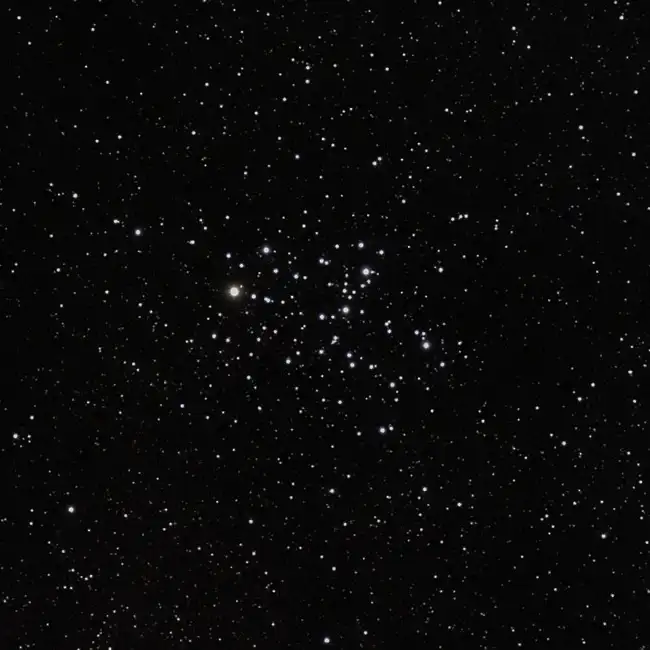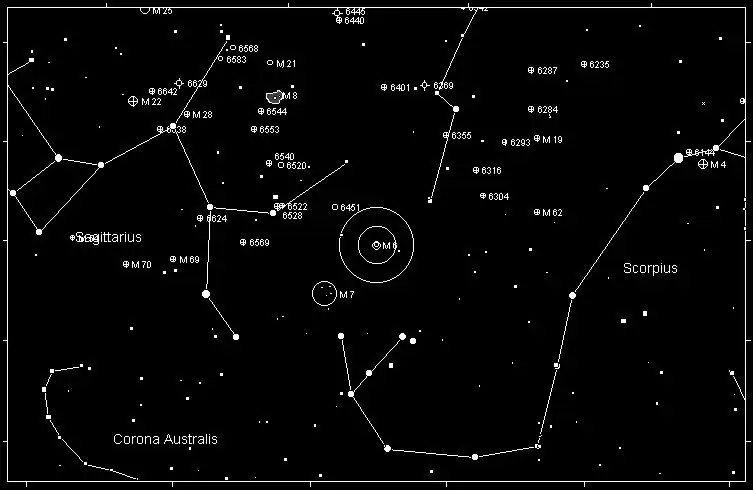Messier 6, also known as the Butterfly Cluster, is an open star cluster located in the constellation Scorpius. The cluster gets its name from the butterfly-like pattern formed by its brightest stars. It is a stunning celestial object, with around 80 stars shining brightly against the backdrop of the Milky Way. The Butterfly Cluster spans an area of approximately 20 light-years across and is estimated to be around 100 million years old, relatively young in cosmic terms.
Magnitude Messier 6 has an apparent magnitude of 4.2, making it easily visible to the naked eye under dark skies. However, its beauty truly unfolds when viewed through binoculars or a small telescope, where the cluster’s stars create a glittering butterfly-shaped pattern. The brightest star in the cluster, BM Scorpii, is a K-type orange giant with a magnitude of 5.5.

Season & Visibility
The best time to observe Messier 6 is during the summer months, particularly between June and August. During this period, the constellation Scorpius is high in the southern sky for observers in the Northern Hemisphere. In the Southern Hemisphere, it can be seen at its best in winter. The cluster is located in a rich region of the Milky Way, making it a stunning target for summer stargazing sessions.
Constellation
Messier 6 is located in the constellation Scorpius, which is one of the most recognizable constellations in the summer sky due to its bright red star, Antares. Scorpius represents the mythological scorpion that is often associated with the tale of Orion, the hunter. The constellation is home to a number of interesting deep-sky objects, including Messier 6, which lies near the center of the scorpion's tail.
How to Find Messier 6
To find Messier 6, begin by locating the bright star Antares, which is the heart of the scorpion and one of the most prominent stars in the summer sky. From Antares, trace your way along the scorpion’s tail to the stars Shaula and Lesath, which form the stinger. Messier 6 lies just to the northwest of this pair, near another star cluster, Messier 7. Both clusters are close together, making them an attractive pairing for observers.
When using a telescope, start with a low-power eyepiece to capture the wide field of view that includes both Messier 6 and Messier 7. Messier 6 will appear as a bright, dense cluster of stars arranged in the shape of a butterfly. You can then switch to a higher magnification to explore individual stars within the cluster.

History
The Butterfly Cluster has been known since antiquity, with some historical records suggesting that the Greek astronomer Ptolemy may have observed it as early as the 2nd century AD. However, it was the French astronomer Giovanni Battista Hodierna who first documented Messier 6 in 1654. Charles Messier later added the cluster to his famous catalog of nebulous objects in 1764.
Messier 6 has been a popular target for both amateur and professional astronomers throughout history. It has been studied for its stellar population and structure, providing valuable insight into the life cycles of stars within open clusters. The study of such clusters also helps astronomers understand the dynamics of star formation within our galaxy.
Conclusion
Messier 6, the Butterfly Cluster, is a delightful object in the night sky that offers a breathtaking sight for stargazers. Its bright stars, arranged in a delicate butterfly pattern, make it one of the highlights of summer observing. Whether viewed with binoculars or a telescope, it serves as a reminder of the beauty and wonder that our galaxy holds.
